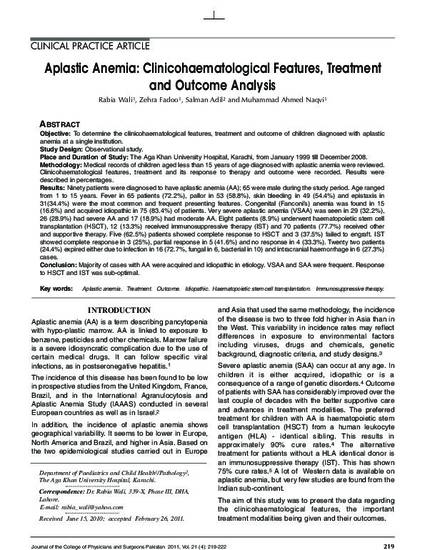
Objective: To determine the clinicohaematological features, treatment and outcome of children diagnosed with aplastic anemia at a single institution.
Study Design: Observational study.
Place and Duration of Study: The Aga Khan University Hospital, Karachi, from January 1999 till December 2008.
Methodology: Medical records of children aged less than 15 years of age diagnosed with aplastic anemia were reviewed. Clinicohaematological features, treatment and its response to therapy and outcome were recorded. Results were described in percentages.
Results: Ninety patients were diagnosed to have aplastic anemia (AA); 65 were male during the study period. Age ranged from 1 to 15 years. Fever in 65 patients (72.2%), pallor in 53 (58.8%), skin bleeding in 49 (54.4%) and epistaxis in 31(34.4%) were the most common and frequent presenting features. Congenital (Fanconi’s) anemia was found in 15 (16.6%) and acquired idiopathic in 75 (83.4%) of patients. Very severe aplastic anemia (VSAA) was seen in 29 (32.2%), 26 (28.9%) had severe AA and 17 (18.9%) had moderate AA. Eight patients (8.9%) underwent haematopoietic stem cell transplantation (HSCT), 12 (13.3%) received immunosuppressive therapy (IST) and 70 patients (77.7%) received other and supportive therapy. Five (62.5%) patients showed complete response to HSCT and 3 (37.5%) failed to engraft. IST showed complete response in 3 (25%), partial response in 5 (41.6%) and no response in 4 (33.3%). Twenty two patients (24.4%) expired either due to infection in 16 (72.7%, fungal in 6, bacterial in 10) and intracranial haemorrhage in 6 (27.3%) cases.
Conclusion: Majority of cases with AA were acquired and idiopathic in etiology. VSAA and SAA were frequent. Response to HSCT and IST was sub-optimal.
Available at: http://works.bepress.com/salman_adil/7/
